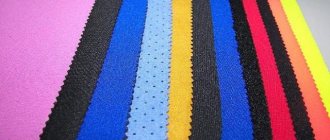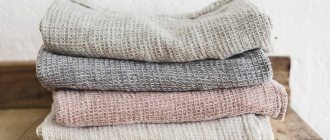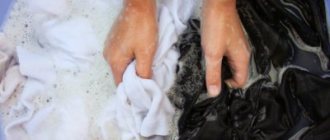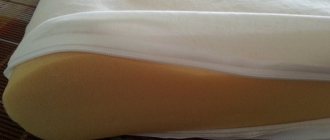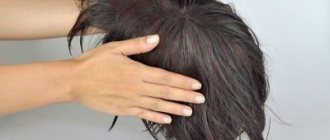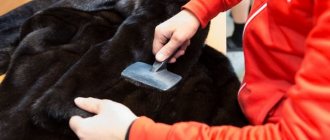Knitted clothing is considered one of the most popular and comfortable to wear. Both adults and children love knitwear for its softness and durability. Cotton, silk, linen, wool, and sometimes synthetic additives are used as raw materials in the production of the material.
In order for your favorite knitted T-shirt to last as long as possible, it is important to follow certain recommendations for caring for the material. Let's figure out how to properly wash knitwear in a washing machine, what detergent to choose and how best to dry the fabric.
Preparatory stage
Before you begin, you need to properly prepare things:
- The clothes are turned inside out.
- Since the bottom of the product and the sleeves can stretch out during wet processing, they should be protected by threading a needle or any other strong and non-fading thread and stitching the problem areas along the edge with wide stitches. Pair the thread only after the product has completely dried.
- Are your clothes stained or heavily soiled? This means that before washing, they soak it - pour cool water into a basin, generously soap the problem areas, and leave for 20 minutes.
- Before washing knitted items, you should carefully study their label: items made from natural fabrics are washed in water at a temperature no higher than 40-50°C, those made from synthetic fabrics - up to 40°C. Do not wash with hot water, as high temperatures may cause the product to shrink.
Reading the label
For many, it will be a “discovery” that manufacturers sew in labels not so that they get in the way and need to be cut off. On this small piece of fabric, the manufacturer places a lot of useful information on caring for the item. If the label says that the item can only be washed at 40 degrees, you should not blame the manufacturer if the clothes stretch or lose their brightness if you wash them in boiling water.
The label is the same instruction manual, so why do we read it for a new phone, but not for a new blouse? After all, the one who sewed this thing is interested in it being worn for a long time, and did everything for this.
Selecting a detergent
It is not recommended to use regular washing powder for washing knitwear - it does not rinse well, and delicate fabric may become damaged after contact with it. Several means are acceptable:
- Soap solution. Laundry soap is rubbed on a fine grater and the shavings are dissolved in water.
- Gel for washing delicate fabrics.
- Shampoo. If you don’t have a special product at hand, you can use any hair shampoo.
- Hard water can deteriorate the appearance of a knitted product; to soften it, use baking soda - about 1 teaspoon will be needed for a medium-sized basin.
- Do not use bleach for knitwear. If it is necessary to make the item white, after washing it, rinse it in water with the addition of a small amount of hydrogen peroxide. A couple of tablespoons of salt or vinegar will help return faded fabric to its rich color - they are dissolved in a bowl of water when rinsing.
Combating the main problem of knitwear – pilling
These unpleasant, unaesthetic and unsightly lumps of lint form on the surface of the material as a result of improper care. Another reason for this rolling may be friction. Often, pellets form on the elbows, in places where a bag or other accessories rub against clothing. It is difficult to combat this phenomenon, but it is possible.
In the “civilized world” they came up with special machines to combat pellets. But our women are not looking for easy ways, so to combat this problem, a variety of means are used - tape, toothpicks and even razors.
Knitted clothing can give a lot of pleasant moments in comfort and aesthetics, but in return it requires careful care and attention. The simple recommendations outlined above will give your clothes longevity.
Handwash
Hand washing is the best way to clean knitted items, since the risk of damaging the product is lower. The process itself is extremely simple:
- A large container is filled with cool water.
- Dissolve a suitable detergent in it, add soda if necessary. Immerse the item in the soap solution and leave for a couple of minutes until the fabric is completely saturated with water.
- Having taken the thing in their hands, they begin to gently squeeze and unclench it with their palms. Movements should go along the product, and not across, otherwise the knitwear may become deformed. You cannot rub the fabric or try to remove stains and heavy dirt with a brush - after this, pellets will form on the knitwear.
- After washing, rinse the item thoroughly, changing the water several times until the soap solution is completely washed out of the fabric. It is important that the rinse water is the same temperature as was used during washing - after contact with colder or hotter water, the product may shrink.
- To make things soft, you can add a teaspoon of glycerin to the water when rinsing.
- You cannot twist the knitwear to try to remove excess water. Before hanging clothes to dry, you need to gently squeeze them with your hands using gentle movements. Start from the top (the neck of a sweater, for example), moving to the bottom.
- Then spread it on a wire rack over the bathtub so that the remaining water drains out. If there is no wire rack, spread a towel on the table, place the washed item on it, roll it up and wring it out. You cannot hang a wet knitwear item on a rope or hanger; the wet fabric will stretch greatly.
Learn some rules
Knitted items are resistant to various mechanical influences, but at the same time, they are prone to deformation. Often, when washed and dried incorrectly, knitwear stretches and pills appear on the clothes. To avoid this, it is important to follow several rules:
- Before washing the item, be sure to turn it inside out. So, the main friction will be on the inside of the fabric, the likelihood of lint rolling off on the outside will be low;
- use suitable cleaning agents. It is better to give preference to gels; dry washing powders increase the risk of pilling;
- run a gentle cleaning mode with a short duration. The less the item “spins” in the drum, the better for the fabric;
- To prevent the knitted T-shirt from losing its shape, choose the program without soaking;
- The product should be dried in a horizontal position on a clean, dry sheet. If you hang knitwear on a clothesline or radiator, the item may become deformed;
- To prevent the neck and sleeves of the blouse from stretching, before loading it into the washing machine, sew these places with light thread and large stitches. After drying, the thread will be easy to remove without leaving marks on the fabric;
- it is better to refuse automatic spinning, or set the minimum speed (up to 400 per minute);
- If the clothes have buttons, before loading them into the drum, treat the loops with colorless varnish on the inside. This will prevent them from stretching.
The likelihood of pilling appearing on knitwear in an automatic washing machine is higher, so if possible, it is better to wash items by hand.
If you follow simple recommendations, knitted clothing will last longer without losing its qualities and original appearance. It is equally important to follow certain rules when wearing it - if the fabric constantly rubs against a belt, bag or backpack, it will not be possible to prevent the appearance of pilling.
In the washing machine
Most modern washing machines have a delicate wash cycle. It can also be used to tidy up knitted items, especially if it contains synthetic threads.
Clothes are fastened with all buttons or zippers, if any, and then turned inside out. Before placing items in the drum, it is recommended to place them in a special washing bag - this will protect the fabric from deformation. You should not wash a large number of things at once - when the drum rotates, they can intertwine and stretch out.
Afterwards, set the manual or delicate wash mode, select a water temperature of maximum 40°C, and either turn off the spin cycle completely or reduce the speed to a minimum. Activate an additional rinse cycle. A special gel for washing delicate fabrics or shampoo is added to the detergent compartment.
After removing items from the drum, remove excess water in the same way as after hand washing.
Ironing knitwear
This procedure also contains soy secrets. Iron knitwear only from the inside out, almost without touching the surface with the iron. If there is a need to smooth out frills or frills on the front side, be sure to use a damp cloth or material.
But knitwear’s best friend is a steam generator, which will help keep knitwear in its original form for a very long time.
Decorative items made of leather or fur cannot be washed or ironed at home. Clothing with such decorations should be dry cleaned.
Drying and ironing
Knitted items are dried exclusively in a horizontal position. When the excess water has drained, the item is laid out on a special mesh dryer, carefully straightening it out. Another method is to use a towel laid out on the table. In this case, it will have to be periodically replaced with a fresh one, and the item will have to be turned over to the other side.
Important! During drying, clothing should not be exposed to direct sunlight.
If creases remain on the knitwear after washing, you can iron it. However, you need to remember that products made from thick threads or those with a relief pattern should not be ironed - the knitting will become flat.
The iron is set to minimum heat. Place an ironing iron - a piece of clean cotton fabric - on top of the item laid out on the ironing board; iron only through it. Do not put too much pressure on the device; movements should be light.
If the ironed item turns out to be wrinkled after storing in the closet, you can lightly moisten it with clean water from a spray bottle, lay it out on the table, straighten it thoroughly and leave it for a while. After the moisture has completely evaporated, the folds in the fabric will disappear.
This may be useful: How to wash cotton.
Getting rid of moisture
For the safety of knitted items, not only careful washing is important. Be sure to dry them properly as well. Basic recommendations to follow:
- Do not hang knitwear on the radiator or near heaters. Accelerated drying will cause the product to lose its shape;
- Limit exposure to direct sunlight. Otherwise, the material will shrink and lose color;
- do not hang knitted clothes on a line;
- dry things on a horizontal surface with a soft towel underneath them.
If you urgently need to dry a knitted dress or sweater, you can hang the product on hangers and blow it with a hairdryer from a distance of at least 20 cm from the fabric. You can use an electric dryer, cover it with a sheet and put knitwear on top.
Interesting:
- Washing knitwear in a washing machine
- Pills appeared after washing
- Washing silk in a washing machine
- How to wash things without pilling?
- What to do if your T-shirt shrinks after washing?
- How to wash linen items?
Reader comments
- Share your opinion - leave a comment
How to store
You can use various methods to store knitwear. The appropriate one is chosen based on the type and properties of a particular item of clothing.
Thus, products made from thick threads (sweaters) can be folded into a stack and stored in a closet or plastic container. In this case, you need to make sure that things made of denser threads lie at the bottom, and light ones - on top. There is no point in filling a shelf or container completely; it is advisable that air can circulate freely there.
It is convenient to store T-shirts and other fine knitwear items, rolled up, in a dresser drawer. It is not recommended to hang knitted items on hangers. However, if necessary, you can do this so that the products do not stretch. This method is only suitable for sweaters; dresses cannot be stored this way, as they may stretch out:
- the sweater is folded lengthwise so that the sleeves are together;
- placed on a hanger so that there are sleeves on one side and the bottom of the product on the other (see photo).
To store knitted dresses, use only soft hangers, and the hem must be pinned to the area in the armpits - this technique helps to avoid pulling the fabric down.
Despite the fact that when washing knitwear you need to adhere to certain rules, caring for it is not too difficult, and items washed in accordance with the listed recommendations retain their original appearance.
This may be useful: How to wash woolen items.
What you need to know about caring for knitwear
The appearance of a new knitwear item in the wardrobe cannot but please both men and women. Even not very fussy children love these soft and comfortable clothes. During the purchase, the sellers promise us that the item will last a long time, will not stretch, will not fade, and will not be deformed. When this all happens after the first few washes, disappointment knows no bounds - you were deceived, poor quality, wasted money. In fact, the person who is to blame for the fact that knitwear quickly loses its appearance is most often not an unscrupulous seller, but a buyer who does not know the basic rules of caring for knitwear.
How to dry and iron knitwear
Knitwear is not hung to dry. It cannot be hung because it stretches and loses its shape. It is better to lightly wring out the item and lay it on a terry towel that will absorb moisture. It is not advisable to iron a dried product. It is better to steam it, touching it minimally with an iron or placing it over hot water - the rising steam will remove all the bruises. But if the product has a long pile or a print, it needs to be ironed from the wrong side. You cannot put pressure on the relief designs with an iron - this will cause them to stretch out or become flat. If a knitted item has inserts made of suede, fur or leather, then it is safer to take it to the dry cleaner.
The role of water temperature for shrinkage of different fabrics
High exposure temperatures, as well as changing hot water to cold water, are the most effective ways to shrink products. The practical application of each method must take into account the type of material.
Cotton
Natural white cotton can not only be processed in hot water, but also boiled.
If the fabric is colored, contains a printed pattern or decorative elements, such processing is unacceptable.
What you can do:
- increase the temperature indicated on the product tag by 15ºС;
- add 150-200 units to the usual spin rates.
Synthetics
Polyester, spandex and other synthetics will be difficult to reduce significantly using any washing techniques. You can try washing it on a normal cycle for synthetics and spinning it at medium speed.
Another method is long-term aging in cold water - it is this that contributes to the shrinkage of synthetics.
If a synthetic product does not shrink, you will have to either throw it away or send it to a workshop for alteration.
Silk
Natural silk should not be exposed to high temperatures : washing in hot water, drying with hot air, treating with hot steam. Silk requires careful handling, otherwise the item may be damaged.
Clothes are soaked in warm water for half an hour. After this, rinse, wring out and hang in a draft.
Jeans
Cotton jeans made from non-Lycra material can be made a little smaller by washing in hot water. It should be taken into account that the shade of the trousers will lighten.
For machine washing the following is installed:
- temperature from +60ºС to +90ºС;
- spin – to maximum;
- automatic drying possible.
This method is not suitable for processing stretch denim fabric, since the lycra included in its composition is not allowed to overheat.
Linen
When processed in hot water, linen clothing may shrink one size . For these purposes, it is possible to use a washing machine or carry out manual processing.
Linen products often have embroidery. If things have this or that decor, then you should not reduce the size by exposure to hot water - the appearance will suffer.
Wool
Natural wool shrinks very well. Under the influence of hot temperature, a thing can shrink greatly - literally by 2 times. The water temperature for reducing clothing should be chosen approximately 15ºС higher than usual.
To achieve the effect, the product is soaked for a short time. After this, wash in cold water. When soaked for a long time, wool tends to stretch rather than shrink.
Knitwear
It is very easy to spoil a knitted item, so it is better to do it manually, very carefully:
- Pour water into the basin at a temperature slightly (10ºС) higher than indicated on the tag.
- Immerse the item for a quarter of an hour.
- Wring out the item through a towel.
- Dry horizontally on a towel.
Washing jeans
Regular denim items can be reduced by a size by washing them in very hot water. The fabric will fade a little and the water will turn blue or black, but this is not critical. But you won’t be able to shrink a stretch denim item. They even have a “shrink to fit” label on them.
When washing in a washing machine, set the temperature to between 60 and 90°C. The maximum spin is required. Drying can be done by machine, or simply hang things on a very hot radiator.
When washing by hand, alternate between very hot water and ice water. Then the thing will definitely decrease in size.
Unfortunately, jeans can become not only narrower, but also shorter. This nuance must be taken into account.
Methods
If you do not have the time or opportunity to read the entire article, watch the video on this topic:
Option #1
Let's consider it.
- Set the washing machine to exactly 60 degrees and wash your clothes.
- The spin mode should be standard.
- Let dry at the highest possible temperature. Of course, if your washing machine has such a mode.
Option No. 2
For example, you have a cotton dress and you have lost 1 size. Clothes can be made smaller by alternating high and low temperatures. If the clothes are clean, then the procedure can be carried out without powder.
The instructions include several steps.
- The dress should be soaked in water close to boiling water.
- After the water has cooled, you can wring out the item.
- Pour cold water with ice into a basin and throw the clothes in there.
- 20 minutes will pass, after which wring out the clothes a little and place them on a large towel (clean).
Do not throw synthetics or silk into boiling water.
Option #3
How to wash an item so that it fits 1 size? Modern irons have a device for releasing steam.
- Set your iron to maximum. Let it heat up.
- Iron, for example, a dress using steam.
How to treat scorched areas on clothes
The scorched area can be wetted with hydrogen peroxide (2% solution) with the addition of ammonia. After this, place the item under bright light and rinse with cold water after 5-10 minutes. You can treat scorched areas using another, similar scheme. Soak in cold water, sprinkle with salt, also expose to light and rinse. You can also deal with a small scorch using a cut onion: rub the scorched area with it and wash it with detergent. Another way to remove opalines is to apply a paste of water and baking soda to them. When it dries, brush off the soda and rinse the fabric. But you need to be careful with this method: the soda may change the color. If this happens, an aqueous solution of vinegar will help restore the shade.
